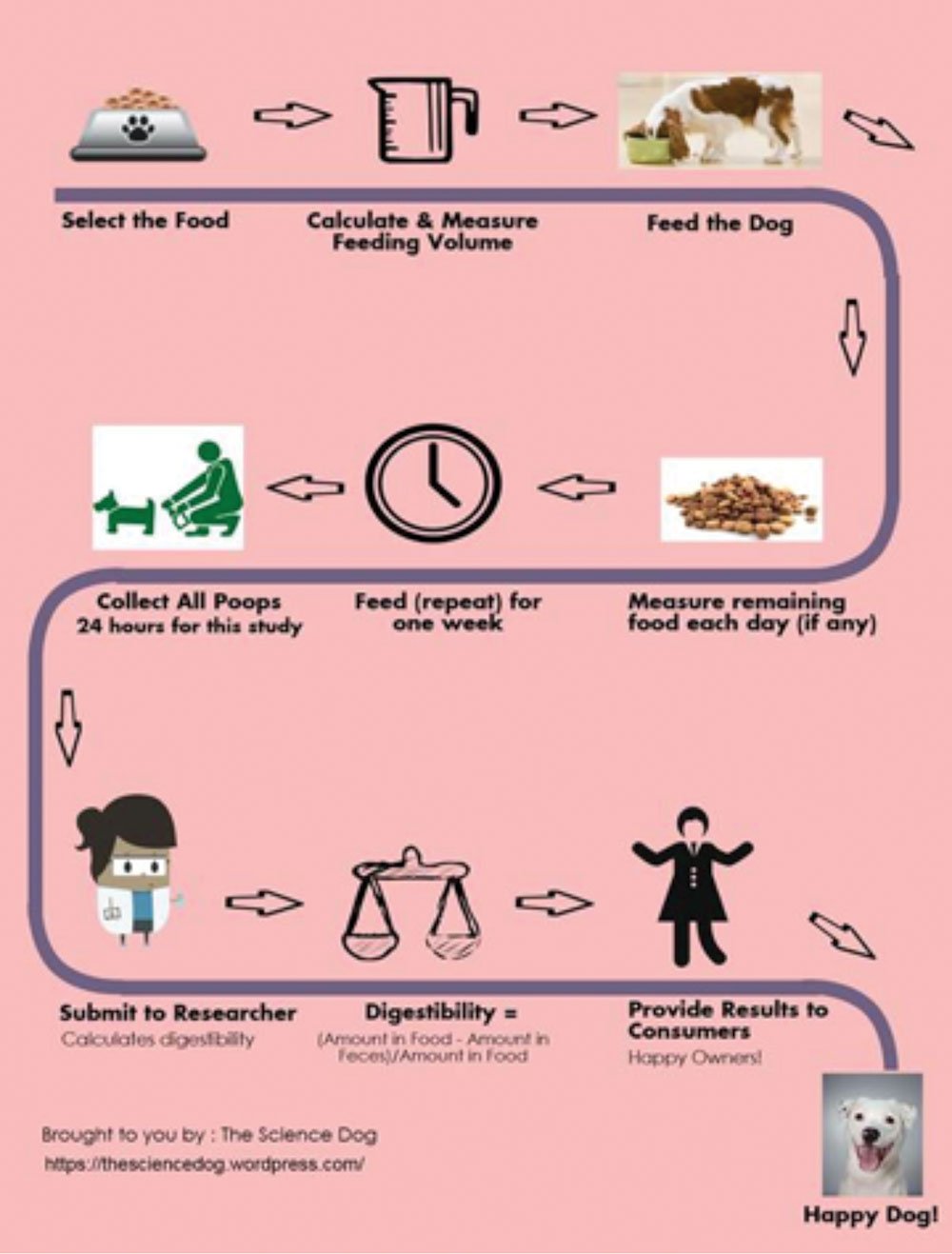In my 2014 nutrition book Dog Food Logic, I emphasized (some might say harped upon) the need for pet food companies to provide digestibility information to consumers. It is not a difficult value to determine and most pet food companies already conduct feeding trials that measure this (yet keep the results to themselves). As one of the most basic measures of food quality, digestibility provides essential information that can help dog owners to select the best food for their dog.
What is digestibility and why does it matter? Digestibility reflects a food’s ability to deliver essential nutrients to the dog who eats it. This ultimately affects not only defecation quantity and quality (how much your dog poops and how the poop looks and smells), and a dog’s propensity for flatulence (no explanation needed), but more importantly, a dog’s long-term health and wellness. The graphic on this page summarizes how digestibility is measured using feeding trials with dogs.
It’s that last step, “Provide Results to Consumers,” that is glaringly absent from the dog food scene. But, I harp (again).
Onward. There is good news to tell.
Good vs. Poor Digestibility in Dog Food
The term digestibility coefficient refers to the percentage of a food that the dog absorbs into his or her body during the process of digestion. As a rule of thumb, dry dog foods with digestibility values of 75 percent or less will be of very poor quality, those with values between 75 and 82 percent are classified as moderate in quality, and foods with digestibility values that are higher than 82 percent are of high quality. If you see products with 88 percent or more reported digestibility, you have a rock star. (For a more detailed explanation of dog food digestibility, see Dog Food Logic.)

The paradox lies in the fact that while many pet food companies routinely measure the digestibility of their products, they are not required to report this information to the people who buy their foods. Most do not provide this information even when it is directly requested. Digestibility matters (a lot), but we cannot judge foods with information that we do not have.
The good news is that two research studies measuring the digestibility of dog foods formulated with different types of protein sources were recently published by a group of animal nutritionists from the Norwegian University of Life Sciences and the University of Copenhagen in Denmark1,2. The first compared the digestibility of dog foods that used three common animal protein meals, and the second compared the use of fresh chicken meat (aka “chicken first”) with poultry meal as protein sources in a dry food. Because all of the protein ingredients that the researchers examined are frequently found in commercial foods, their results may be helpful to dog owners in their quest for a quality food.
Like me, you may be surprised by what they found:
Lamb, Fish, or Poultry Meal?
In the first study, the investigators compared the protein and overall digestibility of three dry (extruded) dog foods that were formulated containing equivalent amounts of either lamb meal, fish meal, or poultry meal1. Because one of the objectives of their work was to determine if mink provide a suitable model for assessing pet food quality, they tested the foods in growing mink, adult mink, and adult dogs.
Results: As a protein source, lamb meal showed significantly lower values for multiple measures of protein quality and essential amino acid content when compared with both poultry meal and fish meal. Even though all three diets were formulated to provide complete and balanced nutrition, the lamb meal diet was found to be deficient in the essential amino acid methionine when digestibility was taken into account.
Although differences between poultry and fish meals were not as dramatic, poultry meal was of lower quality than fish meal. As a protein source in dog food, fish meal had the highest values on almost all quality measures, including digestibility and essential amino acid content. When tested in adult dogs, the protein digestibility values of the three foods were 71.5 for lamb meal, 80.2 for poultry meal, and 87.0 for fish meal.
Overall, this study suggests that, at least for the sources used in this work, the order of protein quality was lamb meal (poor), poultry meal (moderate), and fish meal (high). Additionally, although the reported level of lamb meal in the diet exceeded the minimum methionine requirement for adult dogs, the actual amount of methionine that was available to the dogs (i.e. was digested) was less than their minimum requirement for this nutrient.
Is Fresh Chicken Better?
The team’s second study is groundbreaking. It’s the first to examine whether or not there is a demonstrated benefit to including “fresh” (frozen, actually) chicken in an extruded, dry dog food. This is important because the promotion of “fresh first” on pet food labels is frequently used as a claim for higher protein quality in the product.
The researchers tested the digestibility and amino acid content of fresh, raw chicken (technically referred to as “raw mechanically separated chicken meat”) before processing (cooking) and then again after it was included in a dry dog food to replace about 25 percent of the product’s poultry meal. Because raw meat has been shown to be more digestible than dry rendered protein meals, it was hypothesized that including raw chicken in the dry food would indeed improve the food’s digestibility by several percentage points. (Note: Because mink had been previously shown to be a suitable model for dogs, adult mink were used to test the diets.)
Results: As expected, when tested before processing, the digestibility of raw chicken meat was significantly higher than that of rendered poultry meal (88.2 percent vs. 80.9 percent, respectively). However, when the raw chicken meat replaced 25 percent of the poultry meal in an extruded dry food, the digestibility of the food was not significantly improved (81.3 vs. 80.3, respectively). In addition, the digestibility of several essential amino acids was actually higher in the food containing only poultry meal than in the food that included the raw chicken meat.
Take Away Points
Wow. The results of these two studies contradict several previously accepted (if never actually proven) dog food edicts. These are:
1. Lamb meal is a high-quality protein source for pet foods. Um, apparently not! The first study found that lamb meal was poorly digested (70.5 percent) and provided inadequate levels of the essential amino acid methionine after digestibility was taken into account.
2. All named species meals are superior to “generic” meals. This refers to the general rule of thumb that dog folks should always choose a food that uses a named animal protein source (such as chicken, turkey, salmon, or lamb) over a generic poultry or fish meal. Specifically, choosing lamb over a poultry or fish meal may not get your dog the quality protein you hoped for.
3. The appearance of a fresh animal protein source first on the pet food label means higher quality (more digestible) protein. Nope again – at least in the case of chicken. While the digestibility of fresh chicken meat was higher than that of poultry meal when tested prior to processing, incorporating fresh chicken (as 25 percent of the protein source!) into an extruded food did not improve digestibility or lead to a higher quality product. The researchers speculated that this may have occurred because raw meat ingredients could be more susceptible to damage caused by the heating and drying processes of extrusion than are rendered protein meals.
Regardless of the cause, it appears that “Chicken First” may not be the marketing Holy Grail that pet food companies are promoting it to be.
Up On My Soapbox
This is great information for dog folks to have. Many thanks to this team of researchers, among others (all notably at universities, not from pet food companies) who have been publishing scientific evidence regarding the protein quality, amino acid content, digestibility, and safety of various dog food ingredients and products. We are grateful to them all and hope to see more of these types of studies.
These studies provide needed and essential information, but do not (yet) go so far as to provide us answers to the most important question: “What is the digestibility of the brand of food that I am feeding to my dog?”
I have said this many times before and will say it again:
If pet food manufacturers insist on telling us that their brands of food provide “complete and balanced nutrition” throughout our dogs’ lives, then providing a few very simple measures of the quality of those foods is not too much to ask!
The researchers of these papers agree. Their first paper’s abstract ends, “Furthermore, the study showed that to ensure nutritional adequacy of dog food and to be able to compare protein quality of dog foods, information of amino acid composition, and digestibility is crucial.” (Emphais mine.)
So, pet food manufacturers:Are you listening? Time to step up and provide this information on your labels, websites, or at the very least, in response to direct inquiries. In the meantime, I will continue to report and promote research studies that provide us with the information that we need to choose smart for our dogs.
Cited Studies
1. Tjernsbekk MT, Tauson AH, Matthiesen CF, Ahlostrom O. “Protein and amino acid bioavailability of extruded dog food with protein meals of different quality using growing mink (Neovison vison) as a model.” Journal of Animal Science 2016;
94:3796-3804.
2. Tjernsbekk MT, Tauson AH, Kraugerus OF, Ahlstrom O. “Raw, mechanically separated chicken meat and salmon protein hydrolysate as protein sources in extruded dog food: Effect on protein and amino acid digestibility.” Animal Physiology and Animal Nutrition 2017; 101:323-331.2.
Linda P. Case is the owner of AutumnGold Consulting & Dog Training Center in Mahomet, Illinois. She is also the author of Dog Food Logic, and writes The Science Dog blog.







How can I re-set my password if I do not locate it. Do not wish to be signed in all the time.